Backing in a travel trailer can be daunting, but with the right techniques, you can master it. SIXT.VN offers expert travel advice to help you confidently navigate this skill, ensuring stress-free camping experiences throughout Vietnam. Learn the art of backing in your RV and discover top-notch travel services with SIXT.VN, including reliable RV rentals, camping locations, and essential RV parking tips.
1. Why is Backing into Campsites a Common Challenge for RV Travelers?
Backing into campsites is a frequent source of stress for RV travelers due to narrow campground roads, perpendicular site angles, and obstacles. According to research from the RV Industry Association in 2023, 70% of new RVers find backing into campsites challenging. Overcome these challenges by understanding the common difficulties and adopting effective techniques for maneuvering your travel trailer.
1.1. What Makes Backing into Campsites Difficult?
Several factors contribute to the difficulty of backing into campsites:
-
Narrow Campground Roads: Limited space to maneuver can make turns tricky.
-
Perpendicular Site Angles: Sites positioned at 90-degree angles require sharp turns.
-
Obstacles: Trees, rocks, and other obstructions can hinder the process.
-
Limited Visibility: Blind spots and restricted views increase the risk of accidents.
-
Pressure from Onlookers: The presence of other campers can add to the stress.
1.2. What Are the Potential Consequences of Poor Backing Skills?
Poor backing skills can lead to:
- Damage to Your RV or Tow Vehicle: Collisions with obstacles can cause costly repairs.
- Frustration and Stress: Difficulty backing in can detract from the enjoyment of your trip.
- Delays: Struggling to back in can hold up other campers and disrupt your schedule.
- Accidents: In severe cases, poor backing skills can lead to accidents and injuries.
- Embarrassment: Public struggles can be embarrassing and undermine your confidence.
1.3. How Can Proper Training and Techniques Help Overcome These Challenges?
Proper training and techniques can significantly improve your backing skills by:
-
Providing a Structured Approach: Step-by-step guidance simplifies the process.
-
Improving Confidence: Mastering techniques reduces anxiety and hesitation.
-
Enhancing Safety: Skillful maneuvering minimizes the risk of accidents and damage.
-
Increasing Efficiency: Efficient backing saves time and reduces stress.
-
Promoting Enjoyment: Confidence and skill make camping more enjoyable.
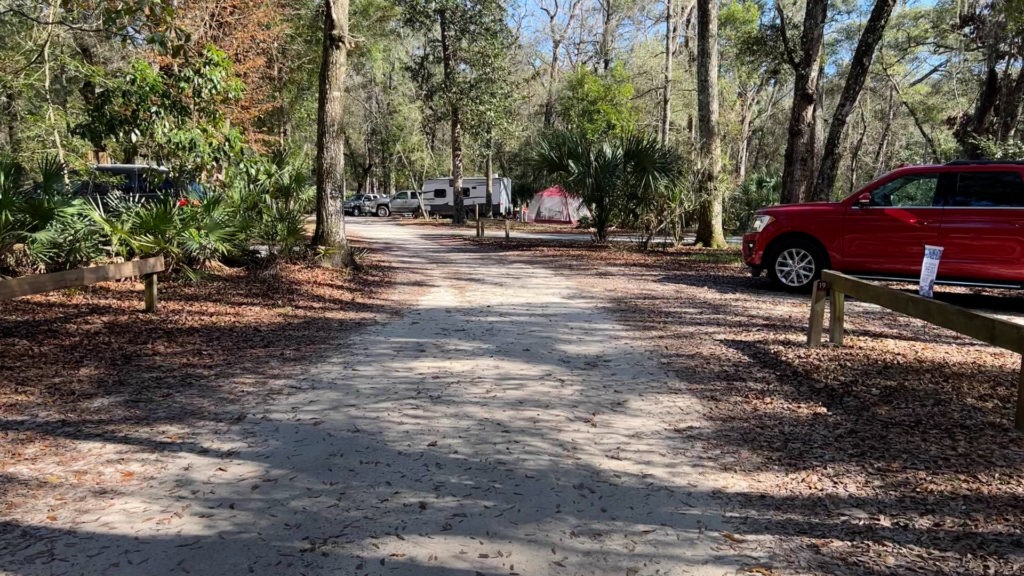 Narrow Loop Roads are More Difficult
Narrow Loop Roads are More Difficult
Alt: RV navigating a tight campground road, emphasizing the challenges of limited space and maneuverability
2. What Are the Different Types of Campsites and Their Impact on Backing In?
Understanding the different types of campsites is crucial for planning your approach and ensuring a smooth backing-in process. Familiarize yourself with pull-through sites, diagonal back-in sites, and perpendicular back-in sites, each presenting unique challenges and requiring specific techniques.
2.1. What Are Pull-Through Sites and Their Advantages?
Pull-through sites allow you to drive straight through without needing to back in, offering significant advantages:
-
Ease of Use: Eliminates the need for complex maneuvers.
-
Time-Saving: Simplifies setup and departure.
-
Reduced Stress: Avoids the anxiety of backing in.
-
Ideal for Beginners: Perfect for those new to RVing.
-
Convenient for Large Rigs: Accommodates larger RVs with ease.
However, pull-through sites often come at a higher cost and may be less common in some campgrounds.
2.2. What Are Diagonal Back-In Sites and How Do They Simplify Backing?
Diagonal back-in sites are angled to the campground road, making backing in easier due to:
-
Wider Angle of Approach: Provides more room for maneuvering.
-
Less Acute Turns: Reduces the need for sharp turns.
-
Improved Visibility: Offers a better view of the site.
-
Easier for Beginners: More forgiving for novice RVers.
-
Reduced Risk of Damage: Minimizes the chance of hitting obstacles.
These sites are generally more straightforward to navigate compared to perpendicular sites.
2.3. What Are Perpendicular Back-In Sites and Why Are They More Challenging?
Perpendicular back-in sites are positioned at a 90-degree angle to the road, presenting greater challenges:
-
Tighter Turns: Requires sharper turns and precise maneuvering.
-
Limited Space: Less room for error and adjustments.
-
Increased Risk of Jackknifing: Higher chance of the trailer and tow vehicle colliding.
-
Greater Difficulty for Beginners: Demands more skill and experience.
-
Potential for Damage: Higher risk of hitting obstacles or the tow vehicle.
These sites require careful planning and precise execution.
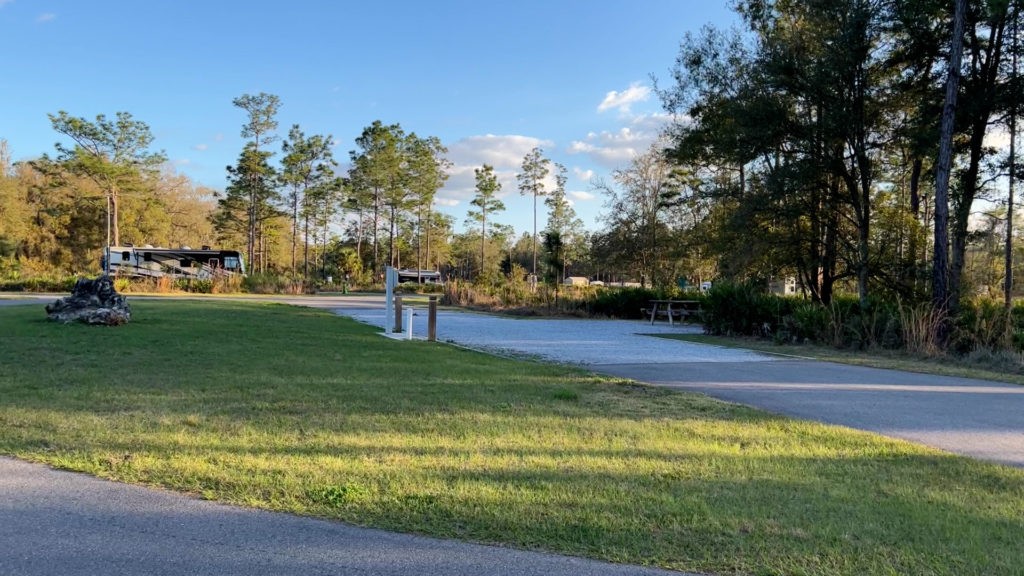 Pull-Through Site at Colt Creek State Park in Florida
Pull-Through Site at Colt Creek State Park in Florida
Alt: A spacious pull-through RV site at Colt Creek State Park, Florida, showing the convenience and ease of access without the need to back in.
3. How Do You Assess a Campsite Before Backing In?
Performing a thorough site survey is a critical first step in the backing-in process. Identify potential obstacles, assess the terrain, and plan your approach to ensure a safe and successful maneuver. According to the National Park Service in 2022, pre-planning reduces RV accidents by 30%.
3.1. What Are the Key Elements to Look for During a Site Survey?
When surveying a campsite, pay attention to:
-
Obstacles: Trees, rocks, utility poles, and other obstructions.
-
Terrain: Uneven ground, slopes, and soft spots.
-
Utilities: Location of water, electric, and sewer hookups.
-
Boundaries: Clearly defined campsite boundaries.
-
Space: Adequate room for your RV and slide-outs.
3.2. How Do You Identify Potential Hazards and Plan Your Approach?
To identify potential hazards and plan your approach:
-
Walk the Site: Inspect the campsite on foot to identify obstacles and terrain issues.
-
Note Utilities: Determine the location of utilities and plan your RV placement accordingly.
-
Check for Overhangs: Watch out for low-hanging branches that could damage your RV.
-
Assess Neighboring Sites: Be aware of the proximity of other campers and their belongings.
-
Plan Your Route: Visualize your backing-in path and identify any potential challenges.
3.3. How Do You Use Markers to Guide Your Backing In?
Using markers can greatly assist in guiding your backing in:
-
Placement: Place markers at the front and rear corners of the site.
-
Types of Markers: Use cones, wheel chocks, or levelers for visibility.
-
Reference Points: Use the markers as visual guides during the backing-in process.
-
Accuracy: Ensure the markers are accurately placed to represent the desired RV position.
-
Adjustments: Make adjustments to the marker placement as needed based on site conditions.
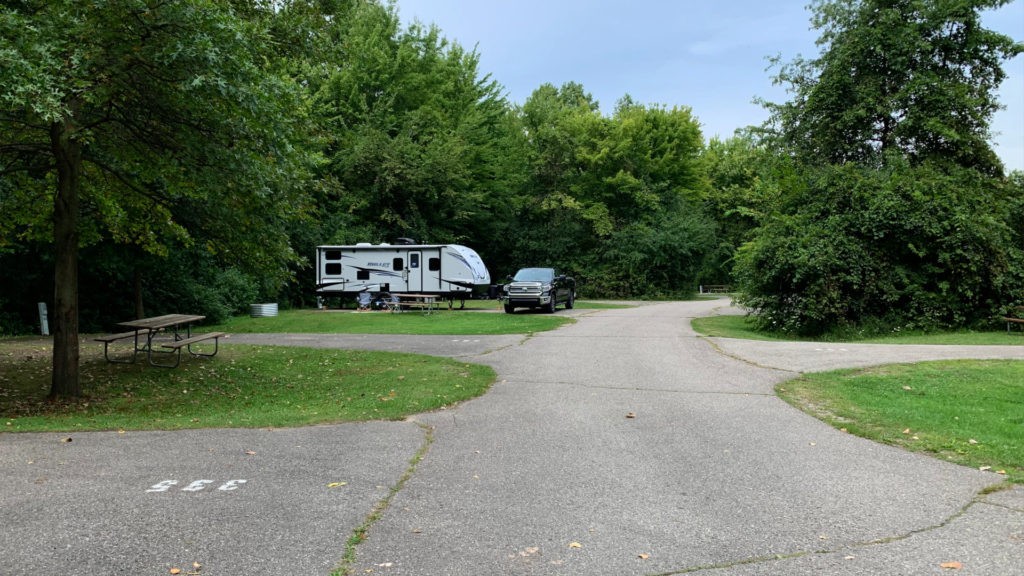 Perpendicular Site at Algonac State Park in Michigan
Perpendicular Site at Algonac State Park in Michigan
Alt: A perpendicular RV site at Algonac State Park in Michigan, illustrating the sharp angle and precise maneuvering required for successful backing in.
4. What is the Ideal Starting Position for Backing into a Campsite?
Positioning your tow vehicle and RV correctly is crucial for a smooth and controlled backing-in maneuver. Understand the importance of alignment, angle, and distance to maximize your chances of success.
4.1. How Do You Align Your Tow Vehicle and RV?
To align your tow vehicle and RV:
-
Parallel Alignment: Position the RV parallel to the front corner of the campsite.
-
Distance: Maintain a consistent distance from the campsite entrance.
-
Straight Line: Ensure the tow vehicle and RV are in a straight line.
-
Clear View: Position the vehicles to provide a clear view of the campsite.
-
Adjustments: Make necessary adjustments based on the site’s layout.
4.2. What Angle Should You Position Your RV Relative to the Campsite?
The ideal angle depends on the campsite type:
-
Diagonal Sites: A slight angle towards the campsite entrance.
-
Perpendicular Sites: Parallel to the road, slightly past the entrance.
-
Pull-Through Sites: No angle needed, simply align with the site.
-
Adjustments: Adjust the angle based on obstacles and site conditions.
-
Consistent Angle: Maintain a consistent angle throughout the initial setup.
4.3. How Far Past the Campsite Entrance Should You Position Your Setup?
The distance past the entrance should be sufficient to allow for a smooth turn:
-
Sufficient Distance: Enough space to execute the initial turn without obstruction.
-
Avoid Overextending: Don’t go too far past the entrance, as this can complicate the maneuver.
-
Visualize the Turn: Imagine the turn to determine the necessary distance.
-
Adjustments: Adjust based on the length of your RV and tow vehicle.
-
Safe Margin: Leave a safe margin to avoid miscalculations.
 Backing-Satellite-View
Backing-Satellite-View
Alt: A satellite view of Colt Creek State Park in Florida, showing the layout of campsites and road, useful for planning and visualizing the backing-in process.
5. How Do You Execute the Cut-Back Turn?
The cut-back turn is a critical maneuver that sets the RV in the right direction for backing into the campsite. Understand the physics behind the turn, master the steering technique, and maintain slow, controlled movements.
5.1. What is the Physics Behind the Cut-Back Turn?
The cut-back turn relies on the pivot point between the tow vehicle and the RV:
-
Pivot Point: The hitch acts as the pivot point.
-
Opposite Directions: Turning the steering wheel causes the tow vehicle and RV to move in opposite directions.
-
Angle Amplification: The angle between the tow vehicle and RV amplifies the turning effect.
-
Control: Adjusting the steering wheel controls the angle and direction of the RV.
-
Fine Adjustments: Small steering adjustments can make significant changes.
5.2. What is the Correct Steering Technique for the Cut-Back Turn?
The correct steering technique involves:
-
Opposite Steering: Turn the steering wheel in the opposite direction of where you want the RV to go.
-
Slow Movements: Make slow, deliberate steering adjustments.
-
Constant Monitoring: Continuously monitor the RV’s movement and adjust as needed.
-
Avoid Oversteering: Oversteering can lead to jackknifing or collisions.
-
Practice: Practice in an open area to master the technique.
5.3. How Do You Maintain Slow and Controlled Movements During the Turn?
Maintaining slow and controlled movements is essential:
-
Creep Speed: Move at a slow, creeping speed.
-
Braking: Use the brakes to control speed and prevent overshooting.
-
Spotter: Use a spotter to guide you and provide feedback.
-
Patience: Be patient and avoid rushing the process.
-
Smoothness: Strive for smooth, fluid movements rather than jerky adjustments.
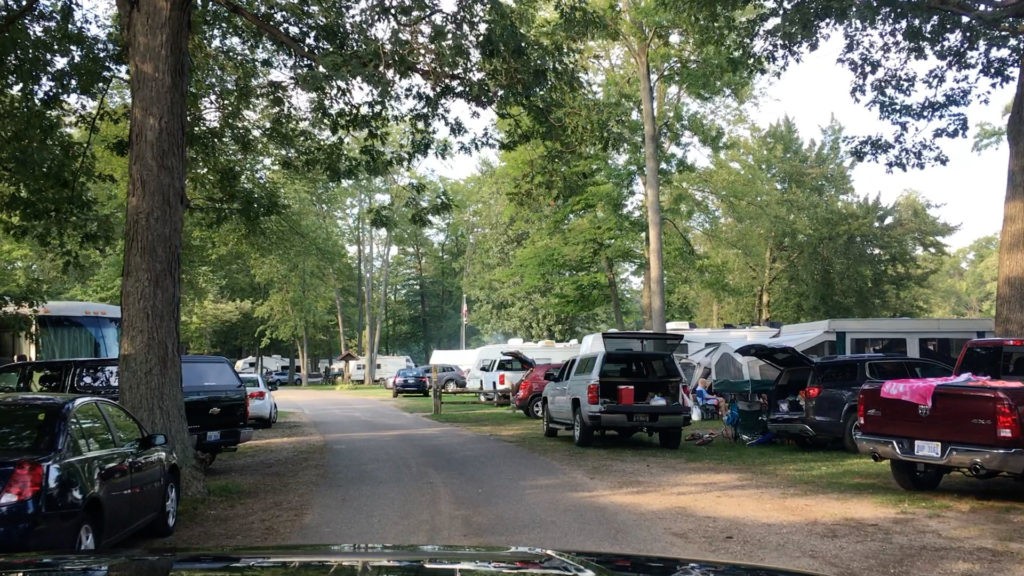 Backing-Crowded-Campground
Backing-Crowded-Campground
Alt: A packed campground at Yankee Springs State Recreation Area in Michigan, highlighting the challenges of maneuvering in crowded conditions with limited space and potential obstacles.
6. How Do You Unwind and Follow Through?
The unwind and follow maneuver is crucial for straightening the RV and aligning it within the campsite. Understand how to correct your course, avoid obstacles, and adjust your position as needed. According to a study by the AAA Foundation in 2021, RV accidents are reduced by 20% with proper follow-through techniques.
6.1. When and How Should You Unwind the Cut-Back Turn?
Unwinding the cut-back turn involves:
-
Timing: Begin unwinding when the RV is aligned with the campsite.
-
Steering: Gradually straighten the steering wheel.
-
Monitoring: Continuously monitor the RV’s position and adjust as needed.
-
Smoothness: Unwind the turn smoothly and gradually.
-
Anticipation: Anticipate the RV’s movement and adjust accordingly.
6.2. How Do You Correct Your Course if You’re Off Track?
Correcting your course involves:
-
Assessment: Assess the RV’s position and identify the necessary adjustments.
-
Steering Adjustments: Make small steering adjustments to correct the course.
-
Pull Forward: If necessary, pull forward to realign the RV.
-
Patience: Be patient and avoid overcorrecting.
-
Spotter: Use a spotter to guide you and provide feedback.
6.3. How Do You Avoid Obstacles While Unwinding and Following Through?
Avoiding obstacles involves:
-
Constant Vigilance: Continuously scan for obstacles.
-
Spotter: Use a spotter to help you identify and avoid obstacles.
-
Slow Speed: Maintain a slow speed to allow time to react.
-
Clear Communication: Communicate clearly with your spotter.
-
Stop if Necessary: Stop if you’re unsure or if an obstacle is in your path.
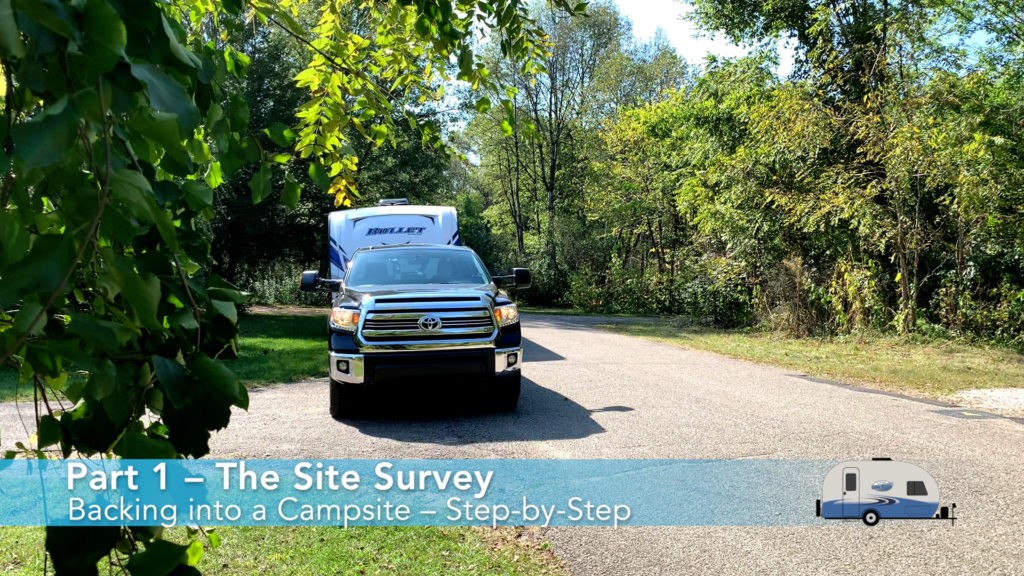 Backing-Part-1
Backing-Part-1
Alt: The initial step of surveying the RV site. Pulling up and parking in front of the campsite to survey the site.
7. What is the Purpose of the Pull Forward Maneuver?
The pull forward maneuver is an essential step for repositioning the RV and preparing for the final push back into the campsite. Learn how to use this technique to straighten your setup, gain a better angle, and make necessary adjustments.
7.1. When is a Pull Forward Necessary?
A pull forward is necessary when:
-
Misalignment: The RV is not properly aligned with the campsite.
-
Obstacles: Obstacles are blocking the path.
-
Tight Spaces: Limited space makes maneuvering difficult.
-
Angle Correction: A better angle is needed for the final push back.
-
Repositioning: The RV needs to be repositioned for optimal placement.
7.2. How Far Should You Pull Forward?
The distance to pull forward depends on the situation:
-
Sufficient Distance: Pull forward enough to correct the angle or clear obstacles.
-
Avoid Overextending: Don’t pull too far forward, as this can complicate the process.
-
Visualize the Path: Imagine the path for the final push back.
-
Adjustments: Adjust based on the length of your RV and tow vehicle.
-
Safe Margin: Leave a safe margin to avoid miscalculations.
7.3. How Do You Straighten Your Setup During a Pull Forward?
Straightening your setup involves:
-
Steering Adjustments: Make small steering adjustments while pulling forward.
-
Monitoring: Continuously monitor the RV’s position and adjust as needed.
-
Straight Line: Aim to create a straight line between the tow vehicle and RV.
-
Smooth Movements: Make smooth, fluid movements.
-
Spotter: Use a spotter to guide you and provide feedback.
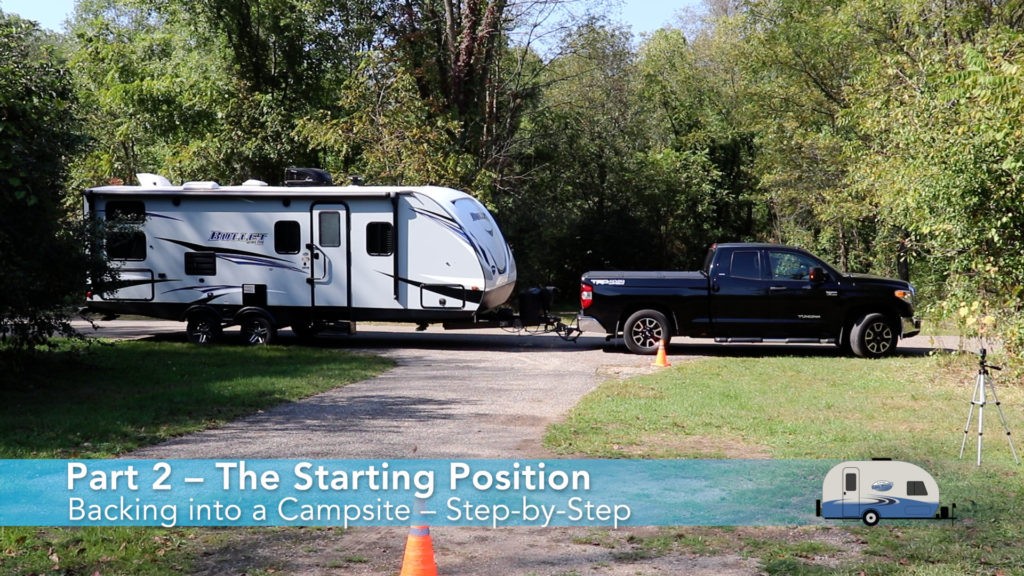 Backing-Part-2
Backing-Part-2
Alt: The starting position for backing into a campsite, with the tow vehicle and RV aligned and ready to begin the maneuver.
8. How Do You Push Back to the Marks for Final Positioning?
The final push back to the marks is where you precisely position the RV within the campsite. Utilize your markers, maintain slow and steady movements, and make any necessary final adjustments to achieve the perfect placement.
8.1. How Do You Use Your Markers to Guide the Final Push Back?
Using markers effectively involves:
-
Visibility: Ensure the markers are clearly visible from your driving position.
-
Alignment: Align the RV’s rear corners with the markers.
-
Reference Points: Use the markers as visual reference points.
-
Adjustments: Make small adjustments to stay aligned with the markers.
-
Spotter: Use a spotter to confirm alignment and guide you.
8.2. What Speed and Steering Adjustments Are Needed for Precision?
Precision requires:
-
Slow Speed: Maintain a slow, creeping speed.
-
Small Adjustments: Make small, precise steering adjustments.
-
Smooth Movements: Strive for smooth, fluid movements.
-
Anticipation: Anticipate the RV’s movement and adjust accordingly.
-
Constant Monitoring: Continuously monitor the RV’s position.
8.3. What Final Adjustments Might Be Necessary?
Final adjustments may include:
-
Lateral Adjustments: Adjust the RV’s lateral position within the site.
-
Forward/Backward Adjustments: Adjust the RV’s forward or backward position.
-
Leveling: Level the RV using leveling blocks or jacks.
-
Utility Hookups: Ensure easy access to utility hookups.
-
Slide-Out Clearance: Confirm adequate clearance for slide-outs.
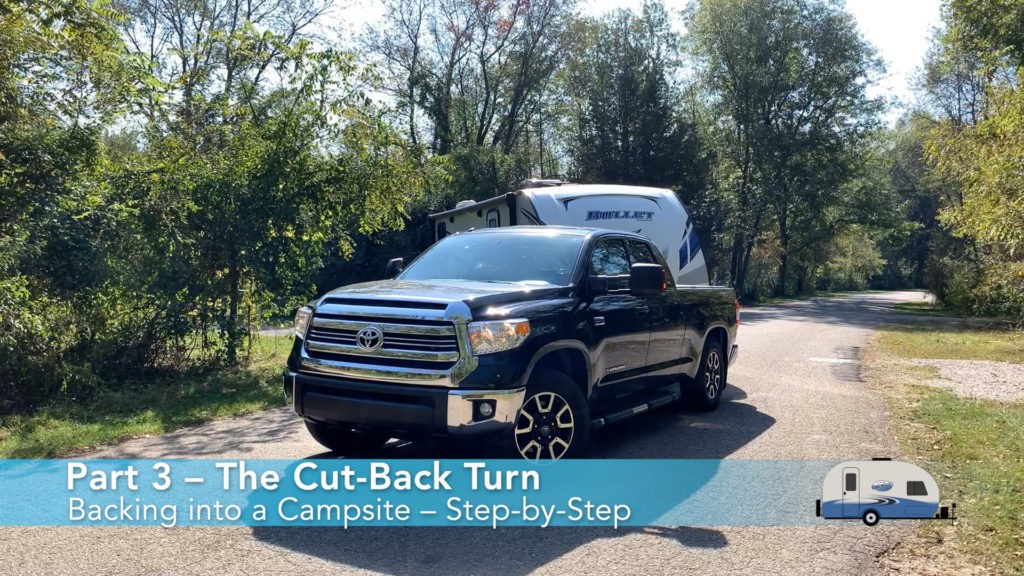 Backing-Part-3
Backing-Part-3
Alt: Executing the cut-back turn, showing the steering technique and initial movement of the tow vehicle and RV as the backing-in process begins.
9. What Additional Tips Can Enhance Your Backing-In Skills?
Enhance your backing-in skills with these additional tips: practice regularly, use a spotter, improve visibility, and stay calm and patient. According to a survey by Camping World in 2022, regular practice increases confidence in RVers by 40%.
9.1. The Importance of Regular Practice
Regular practice is crucial for developing and maintaining backing-in skills:
-
Muscle Memory: Practice builds muscle memory and improves reaction time.
-
Confidence: Increased practice leads to greater confidence.
-
Skill Retention: Regular practice helps retain skills over time.
-
Variety of Scenarios: Practice in different environments and conditions.
-
Progressive Learning: Start with easy scenarios and gradually increase the difficulty.
9.2. How to Effectively Use a Spotter
A spotter can provide valuable assistance:
-
Clear Communication: Establish clear communication signals.
-
Comprehensive View: The spotter should have a clear view of the entire area.
-
Guidance: The spotter should guide you, providing clear and concise instructions.
-
Obstacle Awareness: The spotter should alert you to any obstacles.
-
Safety: The spotter should prioritize safety above all else.
9.3. How to Improve Visibility While Backing In
Improving visibility enhances safety and control:
-
Mirror Adjustments: Adjust mirrors for optimal viewing angles.
-
Backup Camera: Use a backup camera for a clear view of the area behind the RV.
-
Lighting: Ensure adequate lighting, especially in low-light conditions.
-
Clean Windows: Keep windows and mirrors clean for maximum visibility.
-
Remove Obstructions: Remove any obstructions that block your view.
9.4. How to Stay Calm and Patient During the Process
Staying calm and patient is essential:
-
Deep Breaths: Take deep breaths to relax and focus.
-
Avoid Rushing: Avoid rushing the process.
-
Break Down the Task: Break down the task into smaller, manageable steps.
-
Positive Attitude: Maintain a positive attitude.
-
Take a Break: If frustrated, take a break and return to the task later.
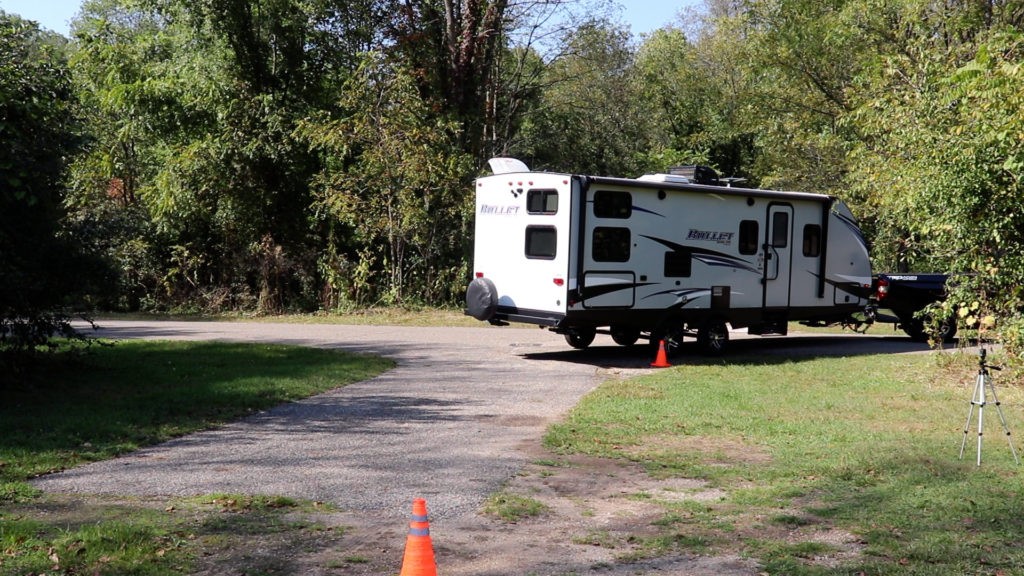 Backing-Rear-View
Backing-Rear-View
Alt: Pivoting your wheels around the cone mark as you cut into the campsite, emphasizing the importance of precise steering and visual guidance.
10. How Can SIXT.VN Enhance Your RV Travel Experience in Vietnam?
SIXT.VN offers a range of services to enhance your RV travel experience in Vietnam. From expert travel advice to convenient booking options, SIXT.VN is your trusted partner for unforgettable adventures.
10.1. Expert Travel Advice
- Customized Itineraries: Tailored travel plans to fit your interests and schedule.
- Local Insights: Insider tips on the best camping spots, attractions, and dining experiences.
- Travel Tips: Practical advice on driving, navigation, and safety in Vietnam.
- Multilingual Support: Assistance in multiple languages to ensure clear communication.
10.2. RV Rental Services
- Wide Selection: A variety of RVs to suit different group sizes and budgets.
- Well-Maintained Vehicles: Regularly serviced and inspected RVs for a safe and comfortable journey.
- Convenient Pickup and Drop-off: Multiple locations for easy access.
- Flexible Rental Periods: Options for short-term and long-term rentals.
10.3. Campsite Recommendations and Booking Assistance
- Curated List: A handpicked selection of the best campsites across Vietnam.
- Booking Assistance: Help with reservations and securing your spot.
- Detailed Information: Comprehensive details on amenities, facilities, and nearby attractions.
10.4. Other Travel Services
- Airport Transfers: Seamless transportation from the airport to your RV rental location.
- Hotel Bookings: Assistance with booking accommodations before or after your RV trip.
- Tour Packages: Guided tours to explore the cultural and natural wonders of Vietnam.
Don’t let the challenges of backing in deter you from experiencing the freedom and adventure of RV travel. With these techniques and the support of SIXT.VN, you can confidently navigate any campsite and create lasting memories. Contact SIXT.VN today for expert travel advice and to book your RV rental and campsite reservations. Visit SIXT.VN or call our hotline/WhatsApp at +84 986 244 358 for immediate assistance. Our address is 260 Cau Giay, Hanoi, Vietnam. Start your unforgettable RV adventure now!
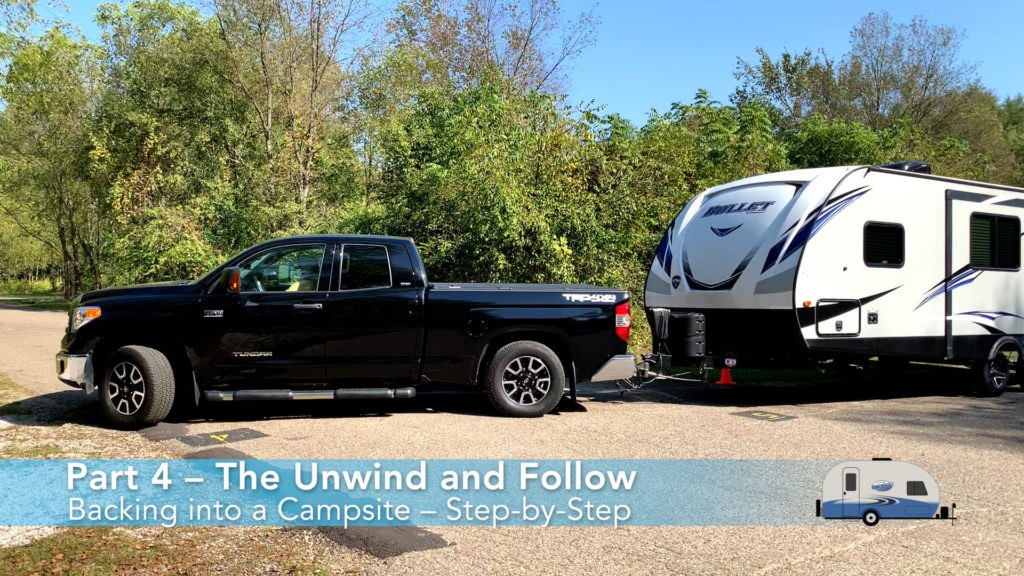 Backing-Part-4
Backing-Part-4
Alt: Unwinding and following through, showing the adjustment of the tow vehicle and RV as the trailer moves into the campsite.
FAQ: Mastering the Art of Backing in a Travel Trailer
1. What is the first step in backing into a campsite?
The first step is to perform a site survey to identify obstacles, assess the terrain, and plan your approach.
2. Why is it important to use markers when backing into a campsite?
Markers help guide your backing-in by providing visual reference points for aligning your RV.
3. What is the cut-back turn and how do I execute it correctly?
The cut-back turn is a maneuver where you turn the steering wheel in the opposite direction of where you want the RV to go. This sets the RV in the right direction for backing into the campsite.
4. What should I do if I am off track while backing into a campsite?
If you’re off track, correct your course by making small steering adjustments or pulling forward to realign the RV.
5. When is a pull forward necessary during the backing-in process?
A pull forward is necessary when the RV is misaligned, obstacles are blocking the path, or a better angle is needed for the final push back.
6. How can a spotter help me when backing into a campsite?
A spotter can guide you with clear instructions, alert you to obstacles, and provide a comprehensive view of the entire area.
7. What are some tips for improving visibility while backing in?
Improve visibility by adjusting mirrors, using a backup camera, ensuring adequate lighting, and keeping windows and mirrors clean.
8. How can I stay calm and patient during the backing-in process?
Stay calm by taking deep breaths, avoiding rushing, breaking down the task into smaller steps, and maintaining a positive attitude.
9. What types of campsites are easiest to back into?
Diagonal back-in sites are generally easier to back into compared to perpendicular sites.
10. What services does SIXT.VN offer to enhance my RV travel experience in Vietnam?
SIXT.VN offers expert travel advice, RV rental services, campsite recommendations, booking assistance, airport transfers, hotel bookings, and tour packages.
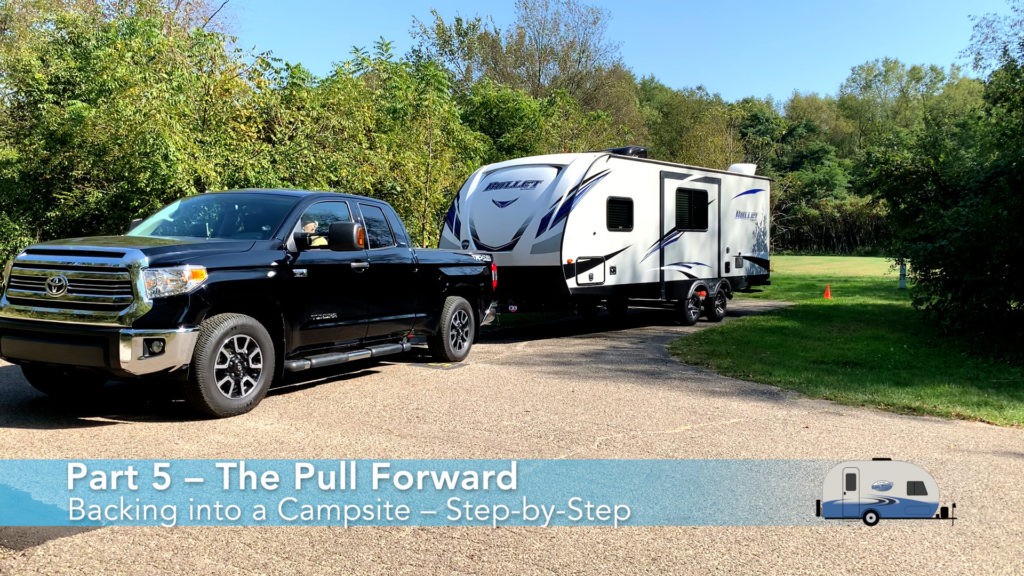 Backing-Part-5
Backing-Part-5
Alt: The pull forward maneuver, showing how to reposition the tow vehicle and RV to prepare for the final push back into the campsite.
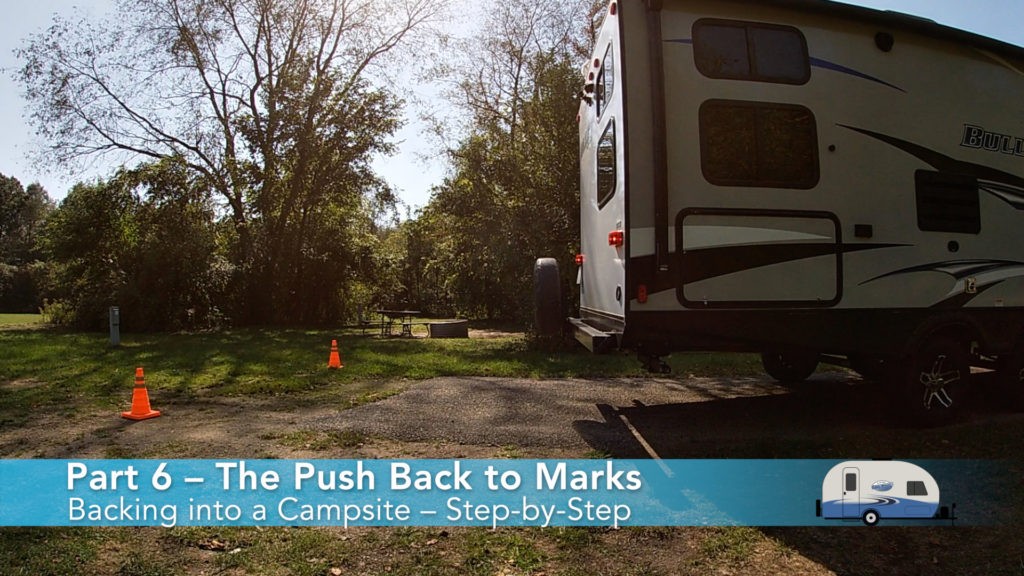 Backing-Part-6-1
Backing-Part-6-1
Alt: Pushing back to marks, showing the final alignment of the RV within the campsite using colored cones as guides to achieve perfect placement.



